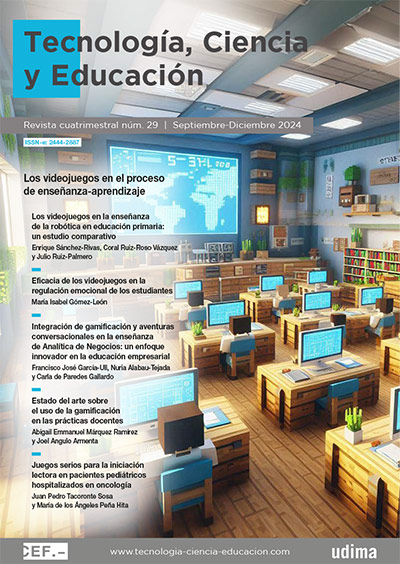Integrating gamification and conversational adventures in Business Analytics education: an innovative approach in business education
DOI:
https://doi.org/10.51302/tce.2024.20215Keywords:
video games, enterprises, management, business economics, artificial intelligence, educational innovationsAbstract
This study delves into the integration of gamification in business education, employing conversational adventures to teach Business Analytics to Marketing students (men and women). Conducted over three interactive sessions, the project merges gamification theory with the practical application of programming skills and narrative design. The initial session introduces students to gamification and its applicability in business environments, highlighting the evolution of conversational adventures from traditional to digital formats. In the second session, students acquire practical programming skills, using ChatGPT to generate Python code executable in Google Colab. Emphasis is placed on the use of control structures such as «input», «print», «if» and «else» to create interactivity in their games. The final session is devoted to project presentations, where students share their games and receive feedback from peers.
The study reveals that gamification, when effectively integrated into business education, not only enhances students' understanding and engagement but also develops technical, creative, and collaborative skills. This innovative approach demonstrates the potential of conversational adventures in business education, opening new avenues for teaching and learning in the digital era.
Downloads
References
Addison, M. (1983). The Hobbit: the software adventure. Computer Gaming World, 3(1), 24-25.
Ángeles Gómez, D. I. y Quintana López, M. (2019). Análisis de sentimientos en videojuegos. ReCIBE, 8(2), 1-23. https://doi.org/10.32870/recibe.v8i2.137
Aylett, R. (2022). Interactive narrative and story-telling. En B. Lugrin, C. Pelachaud y D. Traum (Eds.), The Handbook on Socially Interactive Agents: 20 Years of Research on Embodied Conversational Agents, Intelligent Virtual Agents, and Social Robotics (Vol. 2): Interactivity, Platforms, Application (pp. 463-492). Association for Computing Machinery. https://doi.org/10.1145/3563659.3563674
Baena-Pérez, R., Ruiz-Rube, I., Dodero, J. M. y Bolivar, M. A. (2020). A framework to create conversational agents for the development of video games by end-users. En B. Dorronsoro, P. Ruiz, J. de la Torres, D. Urda y E. G. Talbi (Eds.), Optimization and Learning. OLA 2020. Communications in Computer and Information Science, 1.173, 216-226. https://doi.org/10.1007/978-3-030-41913-4_18
Barzilai, S. y Blau, I. (2014). Scaffolding game-based learning: impact on learning achievements, perceived learning, and game experiences. Computers & Education, 70, 65-79. https://doi.org/10.1016/j.compedu.2013.08.003
Calua Cueva, M. R., Delgado Hernández, Y. L. y López Regalado, Ó. (2021). Comunicación asertiva en el contexto educativo: revisión sistemática. Boletín Redipe, 10(4), 315-334. https://doi.org/10.36260/rbr.v10i4.1274
Deterding, S., Dixon, D., Khaled, R. y Nacke, L. (2011). From game design elements to gamefulness: defining gamification. Proceedings of the 15th International Academic MindTrek Conference: Envisioning Future Media Environments (pp. 9-15). https://doi.org/10.1145/2181037.2181040
Fitzgerald, H. E., Bruns, K., Sonka, S. T., Furco, A. y Swanson, L. (2023). The centrality of engagement in higher education. En R. Sandmann y D. O. Jones (Eds.), Building the Field of Higher Education Engagement (pp. 201-219). Routledge. https://doi.org/10.4324/9781003443353-12
Grasse, K. M., Kreminski, M., Wardrip-Fruin, N., Mateas, M. y Melcer, E. F. (2022). Using self-determination theory to explore enjoyment of educational interactive narrative games: a case study of academical. Frontiers in Virtual Reality, 3, 1-14. https://doi.org/10.3389/frvir.2022.847120
Hamari, J., Koivisto, J. y Sarsa, H. (2014). Does gamification work? A literature review of empirical studies on gamification. Proceedings of the 47th Hawaii International Conference on System Sciences, 3.025-3.034. https://doi.org/10.1109/HICSS.2014.377
Jonassen, D. H. (1999). Designing constructivist learning environments. En C. Reigeluth (Ed.), Instructional-Design Theories and Models: A New Paradigm of Instructional Theory (Vol. II, pp. 215-239). Lawrence Erlbaum Associates.
Kalogiannakis, M., Papadakis, S. y Zourmpakis, A.-I. (2021). Gamification in science education. A Systematic review of the literature. Education Sciences, 11(1), 1-36. https://doi.org/10.3390/educsci11010022
Khaitova, N. F. (2021). History of gamification and its role in the educational process. International Journal of Multicultural and Multireligious Understanding, 8(5), 212-216. https://doi.org/10.18415/ijmmu.v8i5.2640
Koenitz, H. (2018). Narrative in Video Games. En N. Lee (Eds.), Encyclopedia of Computer Graphics and Games. Springer. https://doi.org/10.1007/978-3-319-08234-9_154-1
Landers, R. N., Auer, E. M., Collmus, A. B. y Armstrong, M. B. (2018). Gamification science, its history and future: definitions and a research agenda. Simulation & Gaming, 49(3), 315-337. https://doi.org/10.1177/1046878118774385
Lee, J. J. y Hammer, J. (2011). Gamification in education: What, how, why bother? Academic Exchange Quarterly, 15(2), 1-5.
Martínez López, V., Campo Mon, M. Á., Fueyo Gutiérrez, E. y Dobarro González, A. (2022). La herramienta Kahoot! como propuesta innovadora de gamificación educativa en educación superior. Digital Education Review, 42, 34-49. https://doi.org/10.1344/der.2022.42.34-49
Papert, S. (1993). The Children's Machine: Rethinking School in the Age of the Computer. Basic Books.
Pegalajar Palomino, M.ª C. (2021). Implicaciones de la gamificación en educación superior: una revisión sistemática sobre la percepción del estudiante. RIE, 39(1), 169-188. https://doi.org/10.6018/rie.419481
Prensky, M. (2001). Digital natives, digital immigrants (Part 1). On the Horizon, 9(5), 1-6. https://doi.org/10.1108/10748120110424816
Ríos, A. de los, Muñoz, Y., Castro, P. y Arroyo, J. L. (2019). Gamificación, estrategia compartida entre universidad, empresa y millennials. Red U, 17(2), 73-88. https://doi.org/10.4995/redu.2019.11479
Roig, A. (2019). Jugando en Netflix: Black Mirror-Bandersnatch. COMEeIN, 84. https://doi.org/10.7238/c.n84.1903
Rojas-López, A. y García-Peñalvo, F. J. (2020). Evaluación del pensamiento computacional para el aprendizaje de programación de computadoras en educación superior. Revista de Educación a Distancia (RED), 20(63). https://doi.org/10.6018/red.409991
Savery, J. R. (2015). Overview of problem-based learning: definitions and distinctions. Interdisciplinary Journal of Problem-Based Learning, 9(2), 9. http://dx.doi.org/10.7771/1541-5015.1002
Steffe, L. P. y Gale, J. (Eds.). (1995). Constructivism in Education. Lawrence Erlbaum Associates, Inc. https://doi.org/10.4324/9780203052600
Vygotsky, L. S. (1978). Mind In Society: The Development of Higher Psychological Processes. Harvard University Press.
Werbach, K. y Hunter, D. (2012). For the Win: How Game Thinking Can Revolutionize Your Business. http://ci.nii.ac.jp/ncid/BB15159068
Downloads
Published
How to Cite
Issue
Section
License
Copyright (c) 2024 Francisco José García-Ull, Nuria Alabau-Tejada, Carla de Paredes Gallardo

This work is licensed under a Creative Commons Attribution-NonCommercial-NoDerivatives 4.0 International License.


























